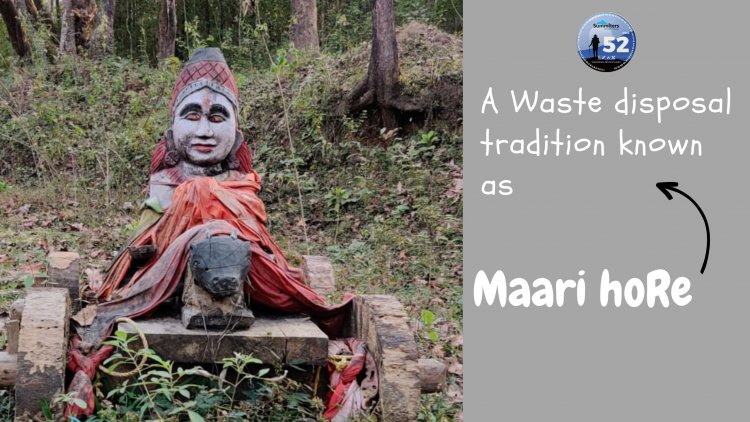A Waste Disposal Tradition called - Maari Hore
Customs and traditions do exist from time immemorial in villages across india. A Unique practice, of disposal of waste known as Maari hore is prevalent in villages across coastal Karnataka and Malenadu region even today.Maari hore is a customary practice where in disposing of waste and keeping the surrounding clean, to keep virulent diseases at bay.

After visiting the Kere basadi at Varanga, we were on our way to Bajagoly, suddenly I noticed an abandoned cart with colorful idols of some goddess just beside the road. A few minutes passed we stopped at a shop, and during a discussion, I came to know that it is a practice existing in the coastal regions related to Maari - A Hindu goddess of rain, predominantly venerated in the rural areas of South India.

A few months later, during my travel from Koppa, on the Jayapura road, I noticed a similar abandoned colorful idol of devi, on a cart. I came to know about it from artiste Prabakhar adve, that they are no ordinary idols and are known as Maari hoRe, - Garbage disposal practice popular and prevalent in coastal and Malenadu region of Karnataka.It has got a cultural history, interesting rituals and beliefs , are followed by the locals.
Maari' is the folk Goddess of misfortunes and epidemics diseases., who is worshiped to seek her blessings for the prevention of diseases like smallpox, Chicken pox, cholera, plague and also natural calamities. The word ‘Maari’ refers to contagious diseases in Kannada. It appears that originally the concept of Maari worship was conceived to drive out epidemic diseases. Maari is normally worshipped in every village and every village has a temple.
The symbolic extradition of Maari, the epidemics, are still prevalent along the Western Ghats and coasts of Karnataka even today.
The village folk of neighboring villages carry the disposals on their head after conducting Poojas (ಉಡಿ ) and extradite the idol and the bundles to the outskirts of their village. And this practice continues as a chain along with the surrounding villages until the bundle reaches the sea or a river. This waste bundle is called 'Maari hore" (ಮಾರಿ ಹೊರೆ ) in Kannada.
Though no festivals are celebrated by the village in which Gadimaari is placed. While lifting the garbage (maari), salt packets offered to get rid of minor diseases and piled up by devotees around the year are also cleared. She is also known adugoolajji (ಅಡುಗೂಲಜ್ಜಿ ) orgadi maari (ಗಡಿಮಾರಿ)
Gadi Maari - Beyond Boundries
Gadi Maari is always kept at the boundary of the village (Gadi means boundary and maari is the goddess of the epidemic ). Normally seen driven on a cart with wheels. As time passes the village expands and grows beyond the border, but the traditions don't become obsolete and retain the jurisdiction.
Commuters on the highway road can see these, colorful carts and discarded dumps.
The Colourful image shows the rural custom of leaving the idol of Gaadi Maari at the outer boundary of the village after due worship.
Though I did not see any garbage around other than Gadi Maari. Let us understand
What is this Maari hore all about ( waste disposal bundle ) contain?
The discarded dump is called maari hore. Interestingly earlier these garbage bundles (maari hore) contain all eco-friendly discarded broken household items. Mostly it contained broken woven cane baskets, broken woven cane cradles, bamboo, and cane baskets) brooms, broken earthen pots, waste cloths, and loads of salt packets .. Deities also offered coins, green bangles, and coconut known as UDI.
Maarihore contains mostly plastic waste. Recently vehicles are hired to lift the Maarihore when it reaches to the towns and they describe the reason that Maarihore becomes a huge pile when it is almost reaching its destination.
The maari hore is also evolving earlier it was just a bundle of eco-friendly disposals. I could see a wooden statue of the female goddess and a male god along with the disposal, there is a big wooden toy cart also be offered as a toy goods carrier.
The concept of maari hore is a great example of effective waste disposal management. The waste travels from village to village until it reaches the sea or a river. unfortunately, now maaari hore is no more an eco-friendly garbage bundle ..it contains all kinds of plastics .. but the rituals and faith continue even today!
So next time when you pass through ghat roads or high ways don't forget to look for these elusive images. If you happenstance see them, don't forget to write to us about it.
The disposal of waste and use of eco-friendly materials is laudable!
However, adhering to customs, meanwhile not polluting water bodies and sources is one thing that needs to be considered a top Priority!












